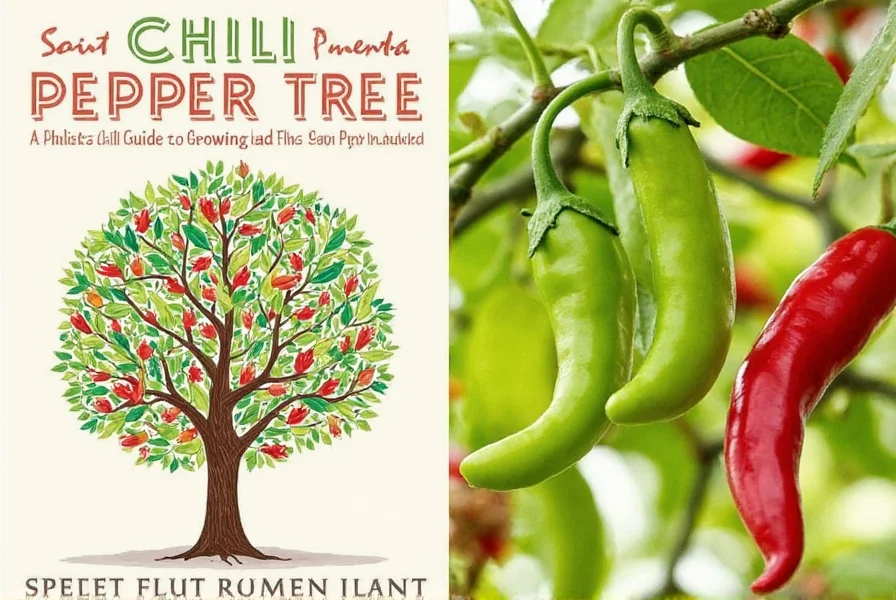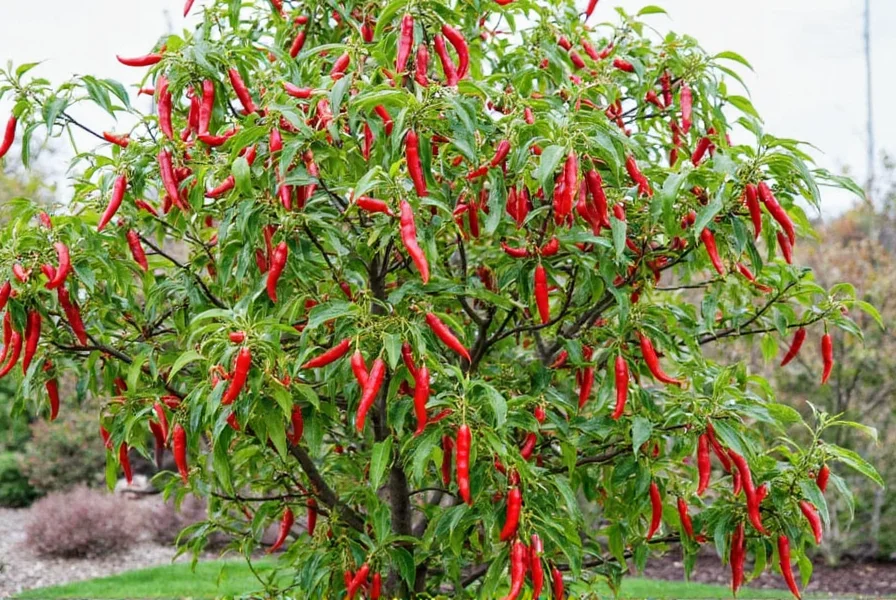Table of Contents
Introduction to Chili Pepper Trees
Chili pepper trees are perennial Capsicum plants that develop woody stems and tree-like structures over time. Unlike annual chili plants, these trees can live for multiple years and grow several feet tall when properly cared for. This guide provides accurate, expert-backed information on growing chili pepper trees, including variety selection, care requirements, and harvesting techniques.
Whether you're a home gardener or culinary enthusiast, understanding how to grow and care for chili pepper trees will help you maximize your harvest and enjoy fresh, flavorful peppers year-round.
Growing Chili Pepper Trees: A Step-by-Step Guide
Growing a chili pepper tree requires specific conditions to thrive. Follow these evidence-based steps:
- Choose the Right Variety: Select varieties known for tree-like growth such as Tabasco, Hatch, or Cubanelle peppers. These varieties have been documented to develop woody stems under proper conditions.
- Plant in Warm, Sunny Areas: Chili pepper trees require at least 6-8 hours of direct sunlight daily. In cooler climates, use containers that can be moved indoors when temperatures drop below 50°F (10°C).
- Use Well-Draining Soil: Opt for soil with high organic matter content and excellent drainage to prevent root rot. A mix of potting soil, perlite, and compost works best.
- Water Regularly: Maintain consistent moisture without overwatering. Water when the top inch of soil feels dry, typically every 2-3 days in warm weather.
- Fertilize Properly: Use a balanced fertilizer with higher phosphorus content during flowering and fruiting stages to maximize pepper production.

Proper care of chili pepper trees can result in continuous fruit production for multiple years, making them a valuable addition to any garden or kitchen.
Types of Chili Peppers You Can Grow on a Tree
Several chili pepper varieties naturally develop tree-like growth patterns. Here's a detailed comparison of popular options:
| Chili Pepper Variety | Heat Level (Scoville Units) | Flavor Profile | Best For |
|---|---|---|---|
| Tabasco | 30,000–50,000 | Tangy, slightly sweet | Sauce making, Mexican cuisine |
| Hatch | 1,000–5,000 | Smoky, earthy | Stuffed peppers, chiles rellenos |
| Cubanelle | 1,000–2,000 | Mild, sweet | Grilling, frying, Italian dishes |
| Jalapeño | 2,500–8,000 | Peppy, grassy | Snacks, salsas, pickling |
| Poblano | 1,000–1,500 | Mild, nutty | Chiles rellenos, soups |

Each variety has unique characteristics that make it suitable for specific culinary applications. Selecting the right variety based on your heat preference and cooking needs is essential for success.
Practical Tips for Chili Pepper Enthusiasts
These expert-backed tips will help you maximize your chili pepper tree's potential:
- Harvest at the Right Time: Harvest peppers when they reach full color and firmness. Picking peppers before they become overripe encourages continuous production.
- Store Properly: Fresh peppers can be stored in the refrigerator for up to two weeks. For longer storage, dry or freeze them in airtight containers.
- Use Gloves When Handling Hot Peppers: Always wear protective gloves when handling hot peppers to prevent skin irritation and accidental eye contact.
- Experiment with Heat Levels: Combine different pepper varieties to create custom heat levels for your recipes.
- Try New Recipes: Chili peppers can be used in everything from cocktails to desserts. Explore creative culinary applications to fully utilize your harvest.
With proper care and attention, your chili pepper tree can provide fresh, flavorful peppers for years to come.
Frequently Asked Questions
What exactly is a chili pepper tree?
A chili pepper tree is a perennial Capsicum plant that develops a woody stem and branching structure over time. Unlike annual chili plants that complete their life cycle in one season, true chili pepper trees can live for multiple years and grow several feet tall when mature. This growth habit is well-documented for specific Capsicum varieties when provided with proper conditions and care.
How long does it take for a chili pepper plant to grow into a tree?
Most chili pepper varieties that develop tree-like characteristics begin showing woody growth after their first full growing season. By the second or third year, with proper care including regular pruning, optimal sunlight, and appropriate fertilization, they will develop a more pronounced tree structure. Research indicates that most gardeners see significant tree-like development within 18-24 months under ideal conditions.
Can I grow a chili pepper tree indoors?
Yes, many chili pepper varieties can be grown indoors as trees with proper care. Compact varieties like Thai ornamental peppers or smaller jalapeño types work best. Indoor chili trees need at least 6-8 hours of direct sunlight (south-facing window) or supplemental grow lights, consistent temperatures between 70-85°F (21-29°C), and good air circulation. Container size should be at least 5 gallons with excellent drainage. Indoor trees may be smaller than outdoor specimens but can still produce quality fruit year-round with proper care.
How do I prune a chili pepper tree for optimal growth?
Pruning should be done in early spring before new growth begins. Remove dead or damaged branches first, then selectively prune to shape the tree and encourage bushier growth. Cut just above leaf nodes at a 45-degree angle. For young trees, pinch off the growing tips to encourage branching. Mature trees benefit from removing up to one-third of the oldest wood each year to stimulate new growth. Always use clean, sharp pruning shears and disinfect between cuts to prevent disease transmission.
Why aren't my chili pepper tree's fruits as hot as expected?
Several factors affect chili pepper heat levels: water stress (peppers become hotter when slightly stressed), soil nutrients (excess nitrogen can reduce capsaicin production), sunlight exposure (more sun generally increases heat), and maturity (fully ripe peppers are often hotter). The specific variety's genetics also play a role - some "hot" varieties can produce milder fruits depending on growing conditions. If you're consistently getting milder peppers than expected, try reducing watering slightly during fruit development or moving the plant to a sunnier location.
Can I grow a chili pepper tree in a container?
Absolutely! Container growing is actually recommended for many climates where winter temperatures drop below 50°F (10°C). Use a container at least 14-18 inches in diameter with excellent drainage. A quality potting mix with added perlite works best. Container-grown chili trees need more frequent watering and fertilizing than in-ground plants. The advantage is you can move them indoors during cold months, potentially extending their life for many years. Just make sure to repot every 1-2 years as the plant grows.
How do I protect my chili pepper tree during winter?
In zones below 9, chili pepper trees need winter protection. For potted trees, move them indoors before the first frost to a sunny window or under grow lights. For in-ground trees in marginal climates, prune back about one-third of the growth, mulch heavily around the base, and consider covering with frost cloth during freezing temperatures. Reduce watering significantly during dormancy but don't let the soil completely dry out. Bring container plants back outdoors gradually in spring after all danger of frost has passed.
Buying Guide: Choosing the Right Chili Pepper Tree
If you're looking to purchase a chili pepper tree, consider these expert recommendations:
Product Features
- Tree Size: Choose a size that fits your available space. Some varieties can grow quite large, while others remain compact.
- Heat Level: Select a variety based on your preferred spiciness level. Consider whether you want a tree that produces mild, medium, or hot peppers.
- Climate Suitability: Check if the variety is suitable for your local climate. Some trees may require more care in colder regions.
- Yield: Look for a tree that offers a good yield of peppers per season.
Advantages
- Continuous Supply: A chili pepper tree provides a steady source of fresh peppers throughout the growing season.
- Ornamental Value: Many chili pepper trees have attractive foliage and colorful fruits, making them a great addition to gardens.
- Cost-Effective: Growing your own peppers saves money compared to buying them at the store.
Use Cases
- Home Cooking: Ideal for those who enjoy adding heat to their meals and want a reliable source of fresh peppers.
- Commercial Use: Suitable for small-scale farmers or market gardeners looking to sell specialty peppers.
- DIY Projects: Great for making homemade sauces, jams, and spice blends.
Target Audience
- Gardeners: Those interested in growing their own food and enjoying the benefits of a chili pepper tree.
- Chefs and Home Cooks: People who love to experiment with spices and want to enhance their cooking with fresh, homegrown peppers.
- Spice Enthusiasts: Individuals who are passionate about exploring different heat levels and flavor profiles.
Suitable Occasions
- Summer BBQs: Fresh chili peppers are perfect for grilling, salsa, and marinades.
- Winter Preserving: Dry or pickle peppers to enjoy them year-round.
- Celebrations: Use spicy ingredients in festive dishes like chili, stews, and sauces.
A chili pepper tree is not just a plant—it's a living spice cabinet that can transform your cooking and gardening experience. Whether you're growing it for practical use or aesthetic appeal, this guide should help you get started on the right foot.
Conclusion
The chili pepper tree is more than just a source of heat—it's a symbol of flavor, versatility, and natural beauty. From its vibrant colors to its wide range of uses, this plant has something to offer everyone, whether you're a professional chef or a casual cook.
By understanding how to grow, care for, and use a chili pepper tree, you can unlock a world of possibilities in your kitchen and garden. Remember, the best way to appreciate the power of chili peppers is to grow your own and experience the satisfaction of harvesting your very own spicy treasures.
So why wait? Start your chili pepper tree journey today and discover the joy of growing and using this incredible spice powerhouse.










 浙公网安备
33010002000092号
浙公网安备
33010002000092号 浙B2-20120091-4
浙B2-20120091-4